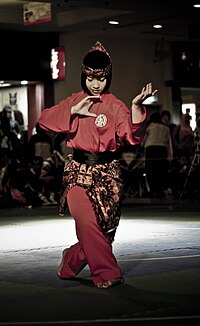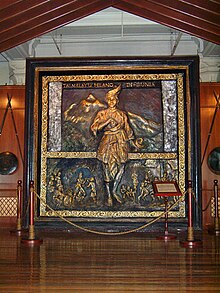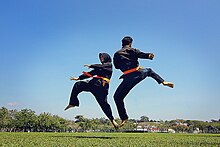Silat Melayu

Silat Melayu (Jawi: سيلت ملايو), literally meaning "Malay silat" is a blanket term for silat styles of the Malay people. The term was originally used in reference to the native silat of Riau, but today it is more commonly used for the systems created in peninsular Southeast Asia, particularly Malaysia, Thailand, Singapore, Brunei and Vietnam. In modern usage, the term is most often used to differentiate the Malaysian styles from Indonesian pencak silat. English-language writings sometimes mistakenly refer to silat Melayu as bersilat but this is actually a verb form of the noun silat.
Etymology
The word Melayu meaning Malay is used somewhat differently from country to country. It originally denoted relation to the Melayu Kingdom in Sumatra, before being used in an ethnic sense. In Indonesia, the word is used for the inhabitants of Riau, Medan and Kalimantan. The martial arts practised by these communities were the first to be referred to as Silat Melayu. Other Sumatrans such as the Minangkabau and Bataks are not considered Malay and so the aforementioned umbrella term did not apply. The word Malay in reference to a broader ethnic or racial identity was first introduced and promoted by British colonists to homogenise and unite the diverse indigenous peoples of the Peninsula. In Malaysia today, the term is defined constitututionally for administrative purposes without ethnological or scientific basis. The ethnic Javanese, Bugis and Minang communities of Malaysia are all "Malay" by law. Thus in colloquial Malaysian usage, any style of silat practised in the peninsula may be informally called Silat Melayu although this is technically incorrect. The issue is further complicated by styles which may have originated outside the Malay community before being introduced to the peninsula by Indonesian settlers, such as Seni Gayong. For simplicity this article will deal with the history and present state of silat in the Malay Peninsula, regardless of any particular style's community of origin.
History
Origins
The silat tradition has deep roots in Malay culture and can trace its origin to the dawn of Malay civilisation, 2000 years ago.[1][2][3][4] The first silat to be described as Melayu is that of Riau. A section of the riverbank population took to the sea in small boats and spread across the Malay Archipelago, coming into contact with various neighbouring ethnicities. Their combatives were crude but nevertheless provided the basis of all silat. On the peninsula they mixed with Deutero-Malays and Chamic people in a wave of migration from mainland Asia around 300 B.C.[5][6] These settlers were rice-farmers from whom modern Malays are directly descended.
Early kingdoms
The Malays had already established regular contact with both India and China before the 1st century. Silat was largely shaped by Chinese and Indian martial arts as evidenced by weapons such as the Indian mace and the Chinese sword. Tradition credits silat tua (lit. "old silat") as the first system of silat Melayu to have been founded on the peninsula. It incorporates four elemental forms like Chinese xingyiquan and several forms based on the Indian Ramayana. The area from Isthmus of Kra to the northern Malay peninsula, a border area between Malaysia and Thailand where it was created, is culturally significant and considered to be the "cradle of Malay civilization and culture".[7][8]
Gangga Negara, one of the peninsula's oldest kingdoms, was eventually destroyed by Rajendra Chola I of the Tamil Chola empire. Today, most Malaysian Indians are Tamils, who influenced several Southeast Asian martial arts through silambam. This staff-based fighting style was already being practised by the region's Indian community when Melaka was founded at the beginning of the 15th century. During the 18th century silambam became more prevalent in the Malay Peninsula than in India, where it was banned by the British government.[9] The bamboo staff is still one of silat's most fundamental weapons.

Champa
The Cham people are an ethnic group of Malayo-Polynesian stock originating in present-day Vietnam and Cambodia. They are believed by many archaeologists to have created the prototype of a kris as far back as 2000 years ago. The Chams established the kingdom of Champa in an area that constitutes today’s southern Vietnam around the first century A.D. The kingdom remained independent from the Chinese who controlled Vietnam's north and in its refusal to submit, Champa frequently waged wars against China[1] as well as other neighbouring kingdoms, Đại Việt and the Khmer Empire.
As a result of their experience in wars, commanders of Champa are known to have been held in high esteem by the Malay kings for their knowledge in silat and for being highly skilled in the art of war, as mentioned in the Sejarah Melayu (Malay Annals). It is said that Muhammad Shah of Malacca had chosen a Cham official as his right hand or senior officer because the Chams possessed skill and knowledge in the administration of the kingdom.[10]
Sultanate era
From the 13th-16th century, many Malay traditions including silat and the Malay language were disseminated throughout the entire archipelago. Kings encouraged princes and children of dignitaries to learn silat and any other form of knowledge related to the necessities of combat. Upper-class nobles would often send their children to study abroad in India or China. Prominent fighters were elevated to head war troops and received ranks or bestowals from the raja.[1] The most famous of these was the Melakan admiral Hang Tuah. He learned martial arts together with his four compatriates - Hang Jebat, Hang Lekir, Hang Kasturi and Hang Lekiu - from the renowned master Adi Putera. In Malaysia today, Hang Tuah is called the "father of silat"[11] which has led to the misconception that he created silat. However, Hang Tuah is more likely to have been one of the art's disseminators rather than its originator[12] since silat is known to have been practised long before the founding of Melaka.
Colonial and modern era
In the 16th century, conquistadors from Portugal attacked Melaka in an attempt to monopolise the spice trade. The Malay warriors managed to hold back the better-equipped Europeans for over 40 days before Melaka was eventually defeated. The Portuguese hunted and killed anyone with knowledge of martial arts so that the remaining practitioners fled to more isolated areas.[13] Even today, the best silat masters are said to come from rural villages that have had the least contact with outsiders.
For the next few hundred years, the Malay Archipelago would be contested by a string of foreign rulers, namely the Portuguese, Dutch, and finally the British. The 17th century saw an influx of Minangkabau and Bugis people into Malaya from Sumatra and south Sulawesi respectively. Bugis sailors were particularly famous for their martial prowess and were feared even by the European colonists. Between 1666 and 1673, Bugis mercenaries were employed by the Johor Empire when a civil war erupted with Jambi, an event that marked the beginning of Bugis influences in local conflicts for succeeding centuries. By the 1780s the Bugis had control of Johor and established a kingdom in Selangor. With the consent of the Johor ruler, the Minangkabau formed their own federation of nine states called Negeri Sembilan in the hinterland. Today, some of Malaysia's silat schools can trace their lineage directly back to the Minang and Bugis settlers of this period.
After Malaysia achieved independence, Tuan Haji Anuar bin Haji Abd. Wahab was given the responsibility of developing the nation's national silat curriculum which would be taught to secondary and primary school students all over the country. On 28 March 2002, his Seni Silat Malaysia was recognised by the Ministry of Heritage and Culture, the Ministry of Education and PESAKA as Malaysia's national silat. It is now conveyed to the community by means of the gelanggang bangsal meaning the martial arts training institution carried out by silat instructors.[14]
Uniform

The silat uniform varies according to style and locality but it is generally based on Siamese outfits. People of the Malay Peninsula traditionally wore sarong and carried a roll of cloth which could be used as a bag, a blanket or a weapon. Some schools may not have any official uniform and allow the students to dress as they normally would, so that they become accustomed to fighting in their daily attire. The standard full dress of today's silat practitioners usually consists of the following:
- The tengkolok and tanjak are headkerchiefs with different ways of tying them depending on status and region.
- The baju Melayu, meaning "Malay clothes" is the male shirt but is also worn by female silat exponents.
- The samping is a waistcloth.
- The bengkung or bengkong is a cloth belt or sash which secures the samping. Some schools colour the bengkung to signify rank, a practice adopted from the belt system of Japanese martial arts.
Training hall
In Malay the practice area is called a gelanggang. They were traditionally located outdoors, either in a specially constructed part of the village or in a jungle clearing. The area would be enclosed by a fence made of bamboo and covered in nipah or coconut leaves to prevent outsiders from stealing secrets. Before training can begin, the gelanggang must be prepared either by the teachers or senior students in a ritual called "opening the training area" (buka gelanggang ). This starts by cutting some limes into water and then walking around the area while sprinkling the water onto the floor. The guru walks in a pattern starting from the centre to the front-right corner, and then across to the front-left corner. They then walk backwards past the centre into the rear-right corner, across to the rear-left corner, and finally ends back in the centre. The purpose of walking backwards is to show respect to the gelanggang, and any guests that may be present, by never turning one's back to the front of the area. Once this has been done, the teacher sits in the centre and recites an invocation so the space is protected with positive energy. From the centre, the guru walks to the front-right corner and repeats the invocation while keeping the head bowed and hands crossed. The right hand is crossed over the left and they are kept at waist level. The mantra is repeated at each corner and in the same pattern as when the water was sprinkled. As a sign of humility, the guru maintains a bent posture while walking across the training area. After repeating the invocation in the centre once more, the teacher sits down and meditates. Although most practitioners today train in modern indoor gelanggang and the invocations are often replaced with a prayer, this ritual is still carried out in some form or another.
Silat pulut

Silat pulut is a sport that utilises agility in attacking and defending oneself.[15] In this exercise, the two partners begin some distance apart and perform freestyle movements while trying to match the each other's flow. One attacks when they notice an opening in the opponent's defences. Without interfering with the direction of force, the defender then parries and counterattacks. The other partner follows by parrying and attacking. This would go on with both partners disabling and counter-attacking their opponent with locking, grappling and other techniques. Contact between the partners is generally kept light but faster and stronger attacks may be agreed upon beforehand. In another variation which is also found in Chinese qinna, the initial attack is parried and then the defender applies a lock on the attacker. The attacker follows the flow of the lock and escapes it while putting a lock on the opponent. Both partners go from lock to lock until one is incapable of escaping or countering.
This game is called silat pulut or gayong pulut because after a performance each player is gifted with bunga telur and sticky rice or pulut. It goes by various other names such as silat tari (dance silat), silat sembah (obeisance silat), silat pengantin (bridal silat) and silat bunga (flower silat). Silat pulut is held during leisure time, the completion of silat instruction, official events, weddings or festivals where it is accompanied by the rhythm of gendang silat (silat drums) or tanji silat baku (traditional silat music).[16] As with a tomoi match, the speed of the music adapts to the performer's pace.
British colonists introduced western training systems by incorporating the police and sepoys (soldiers who were local citizens) to handle the nation's defence forces which at that time were receiving opposition from former Malay fighters. Consequently, silat teachers were very cautious in letting their art become apparent because the colonists had experience in fighting Malay warriors.[16] Thus silat pulut provided an avenue for exponents to hone their skills without giving themselves away. It could also be used as preliminary training before students are allowed to spar, somewhat like Keralan adithada.
Despite its satirical appearance, silat pulut actually enables students to learn moves and their applications without having to be taught set techniques. Partners who frequently practice together can exchange hard blows without injuring each other by adhering to the principle of not meeting force with force. What starts off as a matching of striking movements is usually followed by successions of locks and may end in groundwork, a pattern that is echoed in the modern Mixed Martial Arts.
Weapons

| Weapon | Definition |
|---|---|
| Kris | A dagger which is often given a distinct wavy blade by folding different types of metal together and then washing it in acid. |
| Parang | Machete/ broadsword, commonly used in daily tasks such as cutting through forest growth. |
| Golok | |
| Tombak | Spear/ javelin, made of wood, steel or bamboo that may have dyed horsehair near the blade. |
| Lembing | |
| Tongkat | Staff or walking stick made of bamboo, steel or wood. |
| Gedak | A mace or club usually made of iron. |
| Kipas | Folding fan preferably made of hardwood or iron. |
| Kerambit | A concealable claw-like curved blade that can be tied in a woman's hair. |
| Sabit | Sickle commonly used in farming, harvesting and cultivation of crops. |
| Trisula | Trident, introduced from India |
| Tekpi | Three-pronged truncheon thought to derive from the trident. |
| Chindai | Wearable sarong used to lock or defend attacks from bladed weapons. |
| Samping | |
| Rantai | Chain used for whipping and seizing techniques |
See also
References
- ^ a b c Thesis: Seni Silat Melayu by Abd Rahman Ismail (USM 2005 matter 188)
- ^ James Alexander (2006). Malaysia Brunei & Singapore. New Holland Publishers. pp. 225, 51, 52. ISBN 1-86011-309-5.
- ^ Abd. Rahman Ismail (2008). Seni Silat Melayu: Sejarah, Perkembangan dan Budaya. Kuala Lumpur: Dewan Bahasa dan Pustaka. p. 188. ISBN 978-983-62-9934-5.
- ^ "Black Belt". Rainbow Publications. October 1994: 73. ISSN 0277-3066.
{{cite journal}}: Cite journal requires|journal=(help) - ^ Alan Collins (2003). Security and Southeast Asia: domestic, regional, and global issues. Singapore: Institute of Southeast Asian Studies. p. 26. ISBN 981-230-230-1.
- ^ "The Malays". Retrieved 21 June 2010.
- ^ Keat Gin Ooi (2004). Southeast Asia: A Historical Encyclopedia, From Angkor Wat to East Timor. ABC-CLIO. p. 927. ISBN 978-1-576-07770-2.
- ^ "Rivers deep or mountains high?". Sabrizain.org. Retrieved 20 September 2010.
- ^ Crego, Robert (2003). Sports and Games of the 18th and 19th Centuries pg 32. Greenwood Press
- ^ Sejarah Melayu by A. Samad Ahmad 1996: matter 75
- ^ Sheikh Shamsuddin (2005). The Malay Art Of Self-defense: Silat Seni Gayong. North Atlantic Books. ISBN 1-55643-562-2.
- ^ Donn F. Draeger and Robert W. Smith (1969). Comprehensive Asian Fighting Arts. ISBN 978-0-87011-436-6.
- ^ Zainal Abidin Shaikh Awab and Nigel Sutton (2006). Silat Tua: The Malay Dance Of Life. Kuala Lumpur: Azlan Ghanie Sdn Bhd. ISBN 978-983-42328-0-1.
- ^ Martabat Silat Warisan Negara, Keaslian Budaya Membina Bangsa PESAKA (2006) [Sejarah Silat Melayu by Tn. Hj. Anuar Abd. Wahab]
- ^ Dewan Bahasa dan Pustaka Dictionary (Teuku Iskandar 1970)
- ^ a b Martabat Silat Warisan Negara, Keaslian Budaya Membina Bangsa PESAKA (2006) [Istilah Silat by Anuar Abd. Wahab]
Notations
- Sejarah Silat Melayu by Anuar Abd. Wahab (2006) in "Martabat Silat Warisan Negara, Keaslian Budaya Membina Bangsa" PESAKA (2006).
- Istilah Silat by Anuar Abd. Wahab (2006) in "Martabat Silat Warisan Negara, Keaslian Budaya Membina Bangsa" PESAKA (2006).
- Silat Dinobatkan Seni Beladiri Terbaik by Pendita Anuar Abd. Wahab AMN (2007) in SENI BELADIRI (June 2007)
- Silat itu Satu & Sempurna by Pendita Anuar Abd. Wahab AMN (2007) in SENI BELADIRI (September 2007)
External links
- Silat Melayu News Martial Arts Community Malaysia
- Culture Silat (French)
